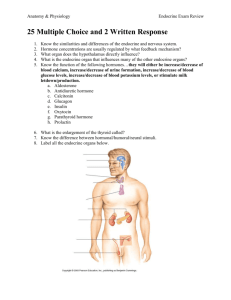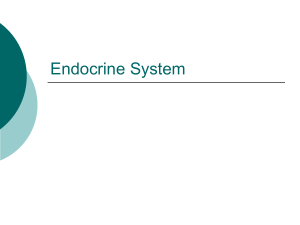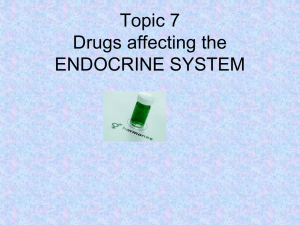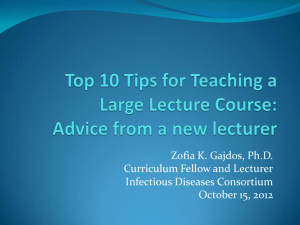Chapter 18 Endocrine System
advertisement
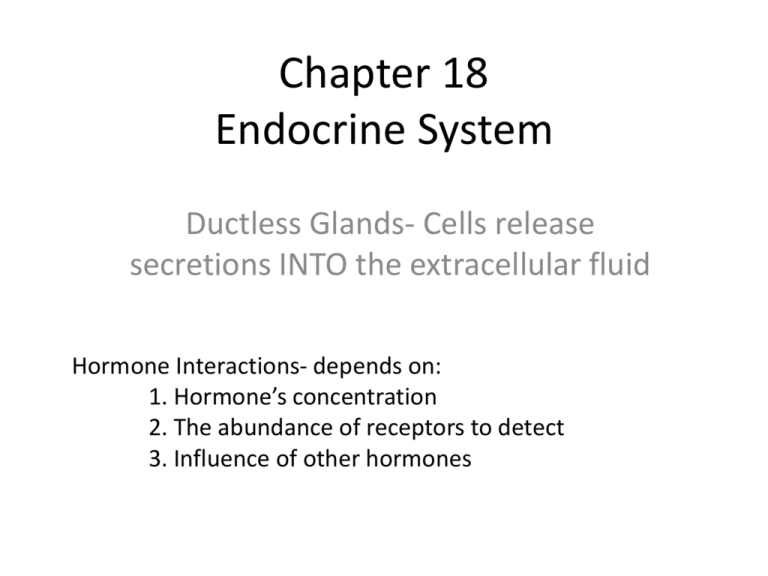
Chapter 18 Endocrine System Ductless Glands- Cells release secretions INTO the extracellular fluid Hormone Interactions- depends on: 1. Hormone’s concentration 2. The abundance of receptors to detect 3. Influence of other hormones 18-1 Homeostasis 1. Cilia in epithelia 2. Cardiac muscle 3. neurons Talking to neighbors Ca, K, Na Local hormones (prostaglandins) Effects outside tissue of origin Ach-muscles Crisis management-NS Hormones- chemical messengers • F(x) Maintains Homeostasis • How? 1. Activate genes to stimulate synthesis of enzymes 2. / rate of protein synthesis 3. Turn an existing enzyme on/off by changing shape • How do local hormones become hormones? – If they have primary effects in their tissues plus secondary effects in other tissues and/or organs – *Paracrine > Endocrine Communication • Similarities of Endocrine & NS? – Chemical messengers (hormones/neurotransmitters) – Negative feedback – Regulate homeostasis Classes of Hormones Class Made From Examples Amino Acid Derivatives Tyrosine & Tryptophan Tyrosine= T4, catecholamines (E, NE, dopamine) Tryptophan= melatonin Peptide Hormones Chains of AA Glycoproteins = TSH,LH,FSH Short chain polypeptides = ADH, OXT Lipid Derivatives Lipids Cholesterol derivatives Eicosanoids(signaling)= leukotrienes (blood clotting), prostaglandins (coordinate cellular activity) Steroids= androgens, progestins, calcitriol Secretion & Distribution • Free (AA or peptides) • Bound (lipids) – F(x)<1hr because: • (thyroid/steroid hormones) 1. Diffuses out of bloodstream & binds to target 2. Broken down/absorbed by liver/kidneys 3. Broken down by enzymes • Remain in circulation longer because they are bound to protein – Why bound to Protein? hydrophilic & dissolves in blood • Reserve supply lasts for weeks How are they Received? • Extracellular • Intracellular • Bind to outer surface of plasma membrane • Catecholamines & peptidesbc not lipid soluble • Bind to inner receptors • Eicosanoids-lipid soluble (dissolve through phospholipid bilayer) • *Protein=not lipid soluble • Activate/deactivate specific genes (DNA in nucleus), change protein synthesis – Ex: testosterone>muscle gain – Thyroid hormones > Rate of enzymes for metabolism Messengers • Hormones bound on outside MUST use intermediary molecule • First messenger: Hormone • Second messenger: does the inside work – cAMP, cGMP, Ca2+ – Uses G proteins to link 1st to 2nd • Ex: G protein activates adenylate cyclase, which makes cAMP, which activates enzyme (kinase), which creates phosphorylation, which opens ion channels Fig 18-3 Endocrine Reflexes controlled by negative feedback • Triggered by: – Humoral Stimuli- changes in extracellular fluid (CSF, blood) – Hormonal Stimuli- arrival of specific hormone – Neural stimuli- arrival of neurotransmitter at a neuroglandular junction • Simple vs complex: – 1 hormone vs multiple steps & hormones Hypothalamus • Integration b/w endocrine & nervous: – Produces ADH (restricts water loss) & OXT (uterus, mammary, prostate), travel down infundibulum, released from posterior pituitary – Sympathetic control of adrenal medullae-release E & NE – Secretes regulatory hormones that controls anterior pituitary, which in turn controls thyroid, adrenals, reproductive organs • Releases hormones in response to change in blood and/or action potentials <How do these get to Anterior pituitary without being diluted? Hypophyseal Portal System • *Ensures hypothalamic hormones entering portal system reach target cells before being diluted • Portal vessels- link 2 capillary networks 1. Bed 1-Fenestrated capillaries at median eminence supplied by superior hypophyseal artery 2. Wrap around infundibulum to anterior lobe 3. Form Bed 2-lead to endocrine cells 4. Hypophyseal veins carry hormones to CV system • 1 way circuit- has to go to all circulation before reaching #1 again Regulatory Hormones • Releasing (RH)stimulates anterior lobe • Inhibiting (IH)prevents anterior lobe Adenohypophysis-7 Tropic hormones-turn something on 1. Human Growth Hormone (HGH) / somatotropin • secretion of insulinlike growth factors, increase AA into proteins • Somatomedins- growth of skeletal muscles, maintains bones in adults • Stimulate stem cells-promotes healing of injuries & tissue repair • Glucose sparing effect-breakdown of stored fat • Diabetogenic effect- stimulates breakdown of glycogen by liver • ↑with sleep & stress, ↓ obesity 2. Thyroid stimulating Hormone (TSH) • synthesis of 2 thyroid hormones, causes thyroid to secrete 3. Follicle stimulating Hormone (FSH) • females-development of eggs, help secrete estrogen • males-stimulates nurse cells in seminiferous tubules to maturate sperm 4. Luteinizing Hormone (LH) • females-secretion of estrogens & progesterone (prepare for pregnancy), ovulation • males-tells testes to secrete testosterone Adenohypophysis Tropic hormones-turn something on 5. Prolactin (PRL) • females-milk secretion by mammary glands • males-?, may help regulate androgens 6. Adrenocorticotropic Hormone (ACTH) • regulate glucocorticoids- blood glucose 7. Melanocyte stimulating Hormone (MSH) • important in animals • Stimulates melanocytes of skin-pigment • found in fetus, very young children, pregnant, disease -Circulating blood of adult humans does not have MSH- so we produce it locally from sun Neurohypophysis 1. Antidiuretic Hormone (ADH) / vasopressin • Responds to osmoregulation: rise in the solute concentration in blood or a fall in blood volume/pressure • Causes kidneys to conserve H2O by decreasing urine, reduces sweating • vasoconstriction > ↑blood pressure • inhibited by alcohol > ↑ urination > hangover 2. Oxytocin (OT) • Women- enhances contractions during child delivery • stimulates milk ejection “letdown” • Men- smooth muscle contraction in ductus deferens & prostate for emission Thyroid Gland • 2 lateral lobes connected by isthmus • Inferior to thyroid cartilage • Anterior to larynx Thyroid Follicles • Lined by Simple Cuboidal • Cavity contains Colloid (dissolved proteins) Thyroid Gland • • • • • Follicle cells make thyroglobulin protein (contains aa tyrosine) Synthesis of hormones requires iodine- pump=iodide >iodine Hormones: tyrosine + iodine Thyroxine (T4) & Triiodothryronine (T3) Synthesis & release rate is controlled by TSH Follicular Hormones T3 & T4 • Affect most cells • Bind to receptors in/on cells until inner levels decrease • F(x): activate genes for production of enzymes involved in glycolysis and ATP production • Calorigenic Effect: increase metabolic rate > heat • Children: TSH increases in cold, also used for development of Skeletal, muscular, NS Parafollicular- Calcitonin • • • • • calcium in blood= inhibits osetoclasts Bone growth Important during starvation and pregnancy Ca = Na permeability = membranes are less responsive Ca = Na = muscle spasms Parathyroid • 2 pairs at posterior Thyroid • 2 cells: – Chief Cells: make Parathyroid Hormone (PTH) – Oxyphils: unknown function Stimulates osteoblasts=increase in bone=less Ca in blood Opposites Stimulates osteoclasts= breakdown of bone = more Ca in blood <Active form of Vit D from kidneys Adrenals/Suprarenals Adrenal Cortex Adrenal Medulla 1. Zona glomerulosa Mineralocorticoids aldosterone-↑Na, ↓K -chromafin cells -part of ANS -Epinephrine (adrenaline) & norepinephrine: • Accelerate glucose breakdown in muscle > strength • Break down stored fat • Break down glycogen in liver • Increase in HR & BP -Fight or Flight responses 2. Zona fasciculata- Glucocorticoids cortisol, cortisone –increase glucose, protein breakdown, antiinflammatory & resist stress 3. Zona reticularis- Androgens & some estrogens -male & female characteristics Pheochromocytomashypersecretion of http://learn.genetics.utah.edu/content/cells/cellcom/ Pancreas • lies b/w stomach and curve of small intestine Endocrine- clusters called Islets of Langerhans: 1. alpha cells – Glucagon -↑blood glucose 2. beta cells – Insulin -↓ blood glucose 3. delta cells – Somatostatin -inhibits secretion of insulin & glucagon 4. F cells – Pancreatic polypeptid -inhibits somatostatin Exocrine- Acini cells- stain darker enzyme fluid for digestion Regulation • Glucagon – stimulates breakdown of glycogen & triglycerides – stimulates production of glucose in liver • Insulin – Accelerates glucose uptake – Accelerates glucose utilization and enhances ATP production – Stimulates AA absorption & protein synthesis – Stimulates Triglyceride formation in adipose Diabetes mellitus Type 1- Insulin Dependent • Genetic • Inadequate insulin production by beta cells Hyperglycemia- increase in blood sugar Glycosuria- sugar in urine Polyuria- excess urination Polydipsia- excessive thirst Type 2- Non-insulin Dependent • Most common • Insulin is produced but tissues do not respond • obesity What can happen? Nephropathy-kidney failure Retinal Damage Heart attacks Neuropathies- nerves Tissue damage- feet Kidneys • Erythropoietin: stimulates bone marrow > RBCs • Renin: blood pressure & electrolytes • Calcitriol: calcium absorption, released in response to PTH Thymus • Thymosin: maturation of T cells Heart (natriuretic peptides) • ANP(atrial) & BNP(brain)-reduction in blood volume & pressure Adipose • Leptin: feedback of appetite, binds to hypothalamic neurons involved with emotion (fullness) • Defective gene > obesity • Thin > late puberty, body fat > fertility, too low body fat > stop menstruating Synergistic effect • some require other hormones in order to work more extensively • ex: oocytes need FSH & estrogen Antagonistic effect • if 2 oppose each other • ex: insulin (makes glycogen) vs glucagon (breaks down glycogen) or PTH vs Calcitonin Permissive effect • First is needed for second • Ex: epinephrine needs thyroid hormones to change energy consumption Integrative effect • Different, but complementary • Ex: calcitriol and PTH Stress Response- General Adaptation Syndrome Eustress- helps you meet challenges Distress- harmful Longer than a few hours After weeks or months Diseases/Disorders • Pituitary Dwarfism: hyposecretion of HGH • Gigantism/Acromegaly: Hypersecretion of HGH Hyperthyroidism • Goiter- enlarged thyroid, insufficient iodine – Weight loss, difficulty concentrating (hyperactive) • Graves Disease- autoimmune disorder, bulging eyes Hypothyroidism • Myxedema- weight gain, swollen & puffy • Hypoparathyroid – Low blood Ca, problems with nerves & Muscular weakness, tetany • Hyperparathyroid – Increase blood Ca, kidney stones, porous bones Glucocorticoids • Addison’s Disease- hyposecretion – Muscle atrophy, kidney damage, inability to tolerate stress • Cushing’s Syndrome- hypersecretion – Rounded face & reddish complexion, weight gain, facial hair in women – Can be caused by taking too many steroid drugs (treat arthritis)





